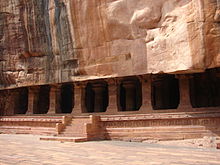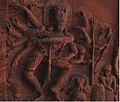Chalukya dynasty
Chalukya dynasty | |||||||||||||
|---|---|---|---|---|---|---|---|---|---|---|---|---|---|
| 543–753 | |||||||||||||
Sanskrit | |||||||||||||
| Religion | Hinduism Buddhism[2] Jainism | ||||||||||||
| Government | Monarchy | ||||||||||||
| Maharaja | |||||||||||||
• 543–566 | Pulakeshin I | ||||||||||||
• 746–753 | Kirtivarman II | ||||||||||||
| History | |||||||||||||
• Earliest records | 543 | ||||||||||||
• Established | 543 | ||||||||||||
• Disestablished | 753 | ||||||||||||
| |||||||||||||
| Today part of | India | ||||||||||||
The Chalukya dynasty (
The rule of the Chalukyas marks an important milestone in the history of
Origins
Natives of Karnataka


While opinions vary regarding the early origins of the Chalukyas, the consensus among noted historians such as John Keay, D.C. Sircar, Hans Raj, S. Sen, Kamath, K. V. Ramesh and Karmarkar is that the founders of the empire at Badami were native to the modern Karnataka region.[3][4][5][6][7][8][9][10][11][12][13]
A theory that they were descendants of a 2nd-century chieftain called Kandachaliki Remmanaka, a feudatory of the Andhra Ikshvaku (from an Ikshvaku inscription of the 2nd century) was put forward. This according to Kamath has failed to explain the difference in lineage. The Kandachaliki feudatory call themselves Vashisthiputras of the Hiranyakagotra. The Chalukyas, however, address themselves as Harithiputras of Manavyasagotra in their inscriptions, which is the same lineage as their early overlords, the Kadambas of Banavasi. This makes them descendants of the Kadambas. The Chalukyas took control of the territory formerly ruled by the Kadambas.[14]
A later record of Eastern Chalukyas mentions the northern origin theory and claims one ruler of Ayodhya came south, defeated the Pallavas and married a Pallava princess. She had a child called Vijayaditya who is claimed to be the Pulakeshin I's father. However, according to the historians K. V. Ramesh, Chopra and Sastri, there are Badami Chalukya inscriptions that confirm Jayasimha was Pulakeshin I's grandfather and Ranaraga, his father.[15][16][17][18] Kamath and Moraes claim it was a popular practice in the 11th century to link South Indian royal family lineage to a Northern kingdom. The Badami Chalukya records themselves are silent with regards to the Ayodhya origin.[19][20]
While the northern origin theory has been dismissed by many historians, the epigraphist K. V. Ramesh has suggested that an earlier southern migration is a distinct possibility which needs examination.
The historians Jan Houben and Kamath, and the epigraphist D.C. Sircar note the Badami Chalukya
Historical sources
Inscriptions in Sanskrit and Kannada are the main source of information about Badami Chalukya history. Among them, the

Travelogues of contemporary foreign travellers have provided useful information about the Chalukyan empire. The Chinese traveller
Legends
Court poets of the Western Chalukya dynasty of Kalyani narrate:
- "Once when Brahma, the creator, was engaged in the performance of the sandhya (twilight) rituals, Indra approached and beseeched him to create a hero who could put to an end the increasing evil on earth. On being thus requested, Brahma looked steadily into the Chuluka-jala (the water of oblation in his palm) and out sprang thence a great warrior, the progenitor of the Chalukyas".Sapta Matrikas("seven divine mothers") and were worshippers of many gods including Siva, Vishnu, Chamundi, Surya, Kubera, Parvati, Vinayaka and Kartikeya.
Some scholars connect the Chalukyas with the Chaulukyas (Solankis) of Gujarat.[46] According to a myth mentioned in latter manuscripts of Prithviraj Raso, Chaulukyas were born out of fire-pit (Agnikund) at Mount Abu. However it has been reported that the story of Agnikula is not mentioned at all in the original version of the Prithviraj Raso preserved in the Fort Library at Bikaner.[47]
According to the Nilagunda inscription of King Vikramaditya VI (11th century or later), the Chalukyas originally hailed from Ayodhya where fifty-nine kings ruled, and later, sixteen more of this family ruled from South India where they had migrated. This is repeated by his court poet Bilhana, who claims that the first member of the family, "Chalukya", was so named as he was born in the "hollow of the hands" of God Brahma.[48][49] Some genealogical accounts point to an Ayodhya origin and claim that the Chalukyas belonged to the Solar dynasty.[50][51][52]
According to a theory put forward by Lewis, the Chalukya were descendants of the "
Periods in Chalukya history
| Chalukya dynasties |
|---|
The Chalukyas ruled over the
Chalukyas of Badami

In the 6th century, with the decline of the
Pulakeshin II, whose pre-coronation name was Ereya,
The Badami Chalukya dynasty went into a brief decline following the death of Pulakeshin II due to internal feuds when Badami was occupied by the Pallavas for a period of thirteen years.[71][72] It recovered during the reign of Vikramaditya I, who succeeded in pushing the Pallavas out of Badami and restoring order to the empire. Vikramaditya I took the title "Rajamalla" (lit "Sovereign of the Mallas" or Pallavas).[73] The thirty-seven year rule of Vijayaditya (696–733) was a prosperous one and is known for prolific temple building activity.[74][75]
The empire was its peak again during the rule of the illustrious
Chalukyas of Kalyani
The Chalukyas revived their fortunes in 973 after over 200 years of dormancy when much of the Deccan was under the rule of the Rashtrakutas. The genealogy of the kings of this empire is still debated. One theory, based on contemporary literary and inscriptional evidence plus the finding that the Western Chalukyas employed titles and names commonly used by the early Chalukyas, suggests that the Western Chalukya kings belonged to the same family line as the illustrious Badami
Chalukyas of Vengi
Pulakeshin II conquered the eastern Deccan, corresponding to the coastal districts of modern
After the decline of the Badami Chalukya empire in the mid-8th century, territorial disputes flared up between the Rashtrakutas, the new rulers of the western deccan, and the Eastern Chalukyas. For much of the next two centuries, the Eastern Chalukyas had to accept subordination towards the Rashtrakutas.[101] Apart from a rare military success, such as the one by Vijayaditya II(c.808–847), it was only during the rule of Bhima I (c.892–921) that these Chalukyas were able to celebrate a measure of independence. After the death of Bhima I, the Andhra region once again saw succession disputes and interference in Vengi affairs by the Rashtrakutas.[101]
The fortunes of the Eastern Chalukyas took a turn around 1000. Danarnava, their king, was killed in battle in 973 by the Telugu Choda King Bhima who then imposed his rule over the region for twenty-seven years. During this time, Danarnava's two sons took refuge in the
Initially, the Eastern Chalukyas had encouraged Kannada language and literature, though, after a period of time, local factors took over and they gave importance to Telugu language.[104][105] Telugu literature owes its growth to the Eastern Chalukyas.[106]
Architecture

The Badami Chalukya era was an important period in the development of South Indian architecture. The kings of this dynasty were called Umapati Varlabdh and built many temples for the Hindu god Shiva.
Their temple building activity can be categorised into three phases. The early phase began in the last quarter of the 6th century and resulted in many cave temples, prominent among which are three elementary cave temples at Aihole (one
The second phase of temple building was at Aihole (where some seventy structures exist and has been called "one of the cradles of Indian temple architecture"
The structural temples at Pattadakal, built in the 8th century and now a UNESCO World Heritage Site, marks the culmination and mature phase of Badami Chalukyan architecture. The Bhutanatha group of temples at Badami are also from this period. There are ten temples at Pattadakal, six in southern dravida style and four in the northern nagara style. Well known among these are the Sangamesvara Temple (725), the Virupaksha Temple (740–745) and the Mallikarjuna Temple (740–745) in the southern style. The Papanatha temple (680) and Galaganatha Temple (740) are early attempts in the nagara – dravida fusion style.[123] Inscriptional evidence suggests that the Virupaksha and the Mallikarjuna Temples were commissioned by the two queens of King Vikramaditya II after his military success over the Pallavas of Kanchipuram.[118] Some well known names of Chalukyan architects are Revadi Ovajja, Narasobba and Anivarita Gunda.[124]
The reign of Western Chalukyas was an important period in the development of Deccan architecture. Their architecture served as a conceptual link between the Badami Chalukya architecture of the 8th century and the
The most notable of the many buildings dating from this period are the
-
Bahubali at Jain Cave temple No. 4 at Badami, 6th century
-
Vishnu image in Cave temple No. 3
-
Bhutanatha group of temples facing the Badami tank
-
The Parvati Temple, located about 140 km southeast to the Badami
-
Aihole – Durga Temple Front View
-
Aihole – Meguti Jain Temple
-
Mallikarjuna temple in dravidian style and Kashi Vishwanatha temple in nagara style at Pattadakal, built 740 CE
-
Dancing Shiva in cave no. 1 in Badami
-
Papanatha temple at Pattadakal – fusion of southern and northern Indian styles, 680 CE
Literature

The
From the period of the Badami Chalukyas, references are made to the existence of Kannada literature, though not much has survived.[147] Inscriptions however refer to Kannada as the "natural language".[148] The Kappe Arabhatta record of c. 700 in tripadi (three line) metre is the earliest available work in Kannada poetics.[149][150] Karnateshwara Katha, which was quoted later by Jayakirti, is believed to be a eulogy of Pulakeshin II and to have belonged to this period.[150] Other probable Kannada writers, whose works are not extant now but titles of which are known from independent references[151] are Syamakundacharya (650), who is said to have authored the Prabhrita, and Srivaradhadeva (also called Tumubuluracharya, 650 or earlier), the possible author of the Chudamani ("Crest Jewel"), a lengthy commentary on logic.[147][152][153][154]
The rule of the Western and Eastern Chalukyas, however, is a major event in the history of Kannada and Telugu literatures respectively. By the 9th–10th centuries, Kannada language had already seen some of its most notable writers. The "three gems" of
Badami Chalukya country
Army
The army was well organised and this was the reason for Pulakeshin II's success beyond the Vindyas.
Land governance
The government, at higher levels, was closely modelled after the
Coinage
The Badami Chalukyas minted coins that were of a different standard compared to the coins of the northern kingdoms.[164] The coins had Nagari and Kannada legends.[25] The coins of Mangalesha had the symbol of a temple on the obverse and a 'sceptre between lamps' or a temple on the reverse. Pulakeshin II's coins had a caparisoned lion facing right on the obverse and a temple on the reverse. The coins weighed 4 grams and were called, in old-Kannada, hun (or honnu) and had fractions such as fana (or fanam) and the quarter fana (the modern day Kannada equivalent being hana – which literally means "money").[165] A gold coin called gadyana is mentioned in a record at the Vijayeshwara Temple at Pattadakal, which later came to be known as varaha (their royal emblem).[164]
Religion

| Part of a series on the |
| History of Karnataka |
|---|
 |
Both
Society
The
In popular culture
The Chalukya era may be seen as the beginning of the fusion of cultures of northern and southern India, making way for the transmission of ideas between the two regions. This is seen clearly in the field of architecture. The Chalukyas spawned the Vesara style of architecture which includes elements of the northern nagara and southern dravida styles. During this period, the expanding Sanskritic culture mingled with local
A celebration called Chalukya utsava, a three-day festival of music and dance, organised by the
See also
- Eastern Chalukyas
- Western Chalukyas
- Chalukya Cholas
- Hoysala Empire
- Chola dynasty
- Kamboi
- Kamboja









